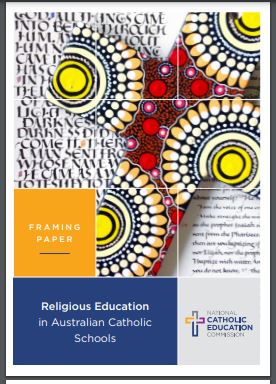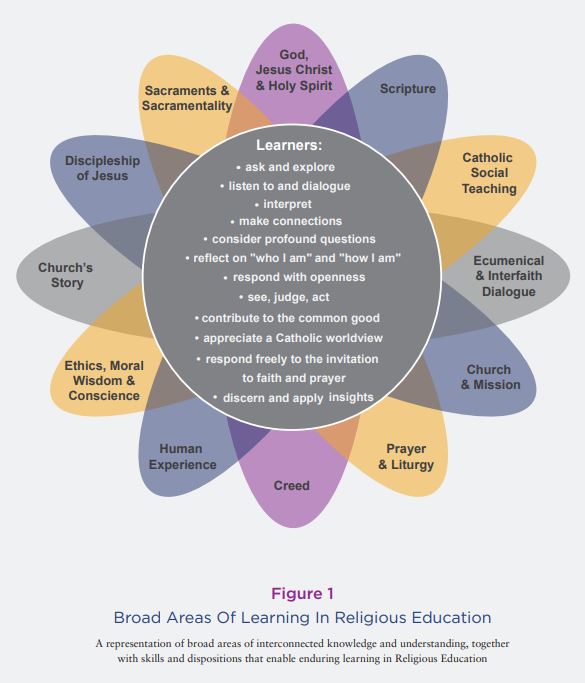1.3.1 Purpose
“Religious Education in Australian Catholic schools develops students’ knowledge and understandings of Christianity in the light of Jesus and the Gospel, and its unfolding story and diversity within contemporary Australian and global society. It expands students’ spiritual awareness and religious identity, fostering their capacities and skills in discerning, interpreting, thinking critically, seeking truth and making meaning. It challenges and inspires their service to others and engagement in the Church and the world.”
NCEC, Framing Paper Religious Education in Australian Catholic Schools, 2018 p.7.
1.3.2 Guiding Principles
The Religious Education curriculum to be taught in Catholic schools in the Diocese of Sandhurst is Source of Life as promulgated by the Bishop of Sandhurst as the mandated curriculum. Religious Education leadership is crucial in animating the Catholic Identity of the school. The Principal and others have the responsibility for religious leadership in the school.
The development of this curriculum is centred on the person and mission of Jesus Christ and has been guided by the clear principles enunciated below.
Religious Education:
1. invites a person into a relationship with the Risen Christ in the context of community;
2. encourages and provides skills for self-reflection, articulation of personal beliefs and meaning framework;
3. is attentive to the interior, spiritual, reflective capacities and dimensions of students and staff;
4. develops an awareness of God, self, others and creation through an intellectual and spiritual journey in the context of the Catholic Tradition;
5. recognises that learners live in a number of different “worlds” including online, peer group, school, home and parish;
6. has Sacred Scripture and the Catechism of the Catholic Church (CCC) as the principal sources for the Religious Education program;
7. has its own intellectual rigour which seeks to develop the knowledge, skills and behaviours that flow from the Catholic Tradition;
8. acknowledges that learners have diverse faith profiles and faith stances, such that Religious Education needs to incorporate a pre-evangelisation stance as well as catechesis;
9. calls us to respect God’s creation and responsibly exercise our creative spirit;
10. opens possibilities for personal meaning-making;
11. offers reflective learning opportunities within and beyond the classroom; a sequential F-12 course of study; promotes Post Critical Belief through a recontextualisation of the Catholic Tradition (as the host tradition) in dialogue with other faith traditions and life philosophies;
12. requires a pedagogy through which teachers can be seen as witnesses, specialists and moderators so as to invite students to discipleship and mission;
13. is taught, developed and resourced with the same commitment as all other learning areas;
14. involves the expectation that teachers of Religious Education will have achieved the appropriate accreditation within five years of gaining employment in Catholic schools and
will maintain the required qualification Accreditation to Teach Religious Education and Lead in a Catholic School;
15. supports and contributes to a systematic, holistic and comprehensive school learning environment which includes the prayer, liturgical and sacramental life of the school, opportunities for retreats and reflection experiences, community outreach, social action and justice programs and the embedding of a Catholic perspective or Catholic worldview across
the whole school curriculum;
17. links our Catholic story to our own personal story, connecting life and faith, faith and culture;
18. nurtures familiarity with, respect for, and acceptance of different religious positions so that we can live peacefully and justly together; and,
19. engages students with the implications of faith for personal morality and the ethics of shared life in society, which may be expressed and developed through social justice programs.
Diocese of Sandhurst, Religious Education Policy (2020).
1.4 Aims
Religious Education is a lifelong process to which Catholic schooling contributes. Its aims are to:
• foster an encounter with the risen Christ;
• create opportunities for each individual to grow in understanding of, and relationship with, Christ who reveals God;
• assist individuals to know and celebrate the Catholic faith Tradition, to appreciate the faith traditions of others, and to grow in literacy in faith;
• provide opportunities for individuals to search, experience, participate, question, critique and dialogue on matters of faith and meaning with the view of growing in the art of discernment;
• provide opportunities for individuals to participate in the life and rituals of the Catholic community, where faith is celebrated, proclaimed, nourished and communicated to others;
• guide individuals to interpret the contemporary culture in the light of Catholic Tradition and become transforming agents in the world; and
• encounter, learn from, share and engage with Aboriginal Spirituality, diverse histories and cultures.
In responding to the ‘signs of the times’ and the mission of reconciliation, it is the intention of this curriculum to:
• be faithful to the Tradition of the Catholic Church while drawing on the richness of contemporary theology;
• belong within the culture of the school, working in harmony with home and parish;
• be inclusive in that it respects and responds to differences in culture, background and experiences, in particular to First Nations Australians;
• employ effective strategies for teaching and learning, especially those that can most engage students in reflective exploration of Catholic teaching, culture and worship: and
• be organised within a sequential F-12 framework, supported by appropriate policies and Programs.
NCEC Framing Paper for Religious Education page 17





Follow